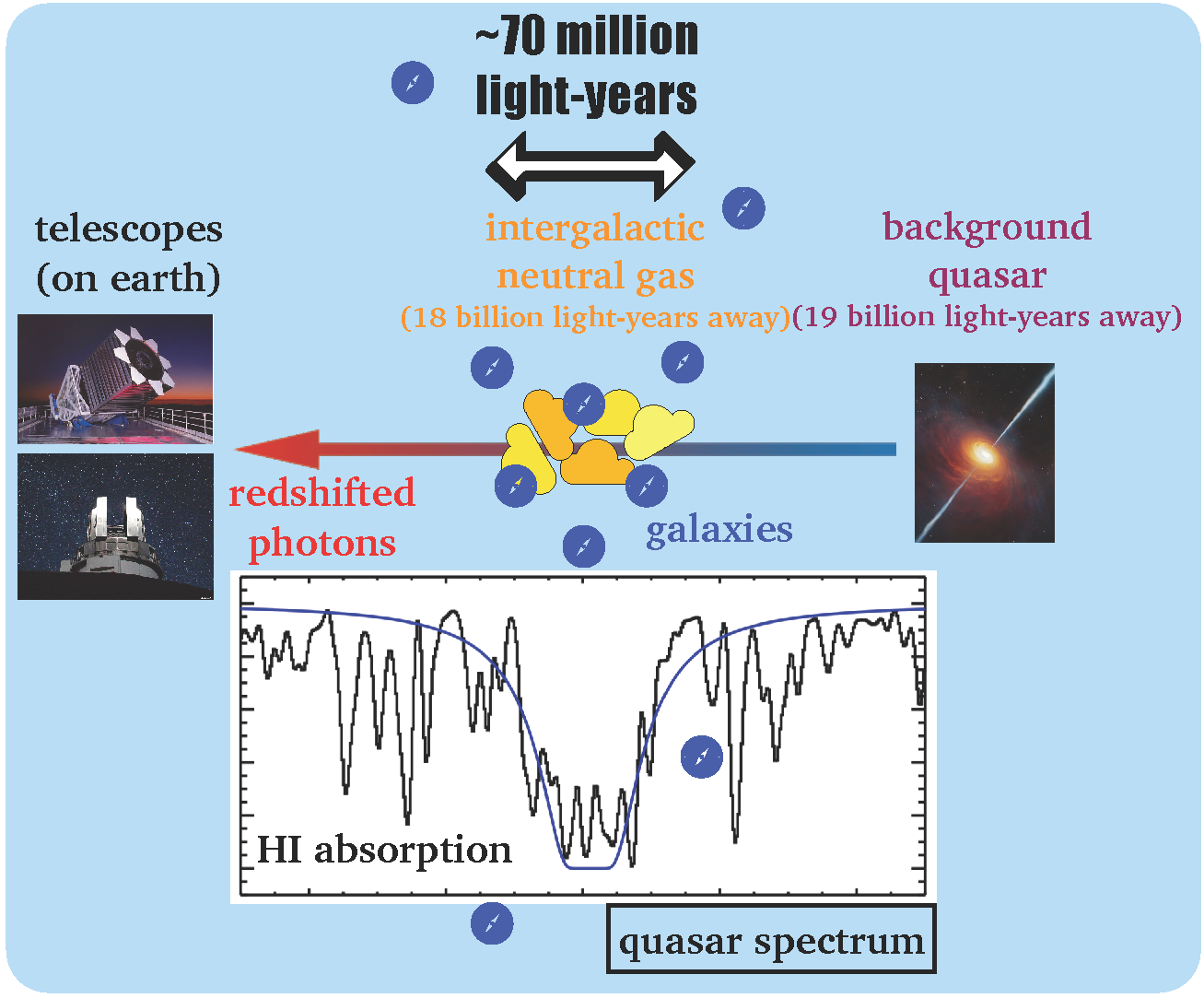June 09, 2021
Galaxies and intergalactic neutral hydrogen dance together at the Cosmic Noon
SOKENDAI Publication Grant for Research Papers program year: 2020
LIANG Youngming, Astronomical Science
Statistical Correlation between the Distribution of Lyα Emitters and Intergalactic Medium H i at z ~ 2.2 Mapped by the Subaru/Hyper Suprime-Cam
Journal: The Astrophysical Journal publish year: 2021
DOI: 10.3847/1538-4357/abcd93

The illustration shows how neutral hydrogen (HI) absorption imprinted in the spectra of background quasars can give us a hint to understand the massive structures. Photons from a distant quasar leave their wavelengths redshifted due to the cosmological expansion, and the intergalactic neutral gas will leave its 'footprint' as the HI absorption feature at the specific wavelength. A group of neutral gas distributed closely will help us find a strong absorption in the quasar spectrum caused by the overlapping HI absorption. According to simulations, such grouping neutral gas is also associated with galaxy high-density regions (Cai et al. 2017). We utilize this technique to search for the high-density regions with the 8.2-meter Subaru Telescope, and have observationally confirmed that there is a moderate and positive correlation between galaxies and intergalactic neutral hydrogen at the Cosmic Noon, an era 10 billion years before or equivalently, 18 billion light-years away from us.
How galaxies and the neutral hydrogen (HI) gas in the intergalactic medium (IGM) interplay with each other is an unsolved problem. The answer to it is a critical key for the fields of astronomy and cosmology: the formation and evolution of large-scale structures on scales of millions of light-years. Due to gravitational effects, galaxies and IGM gas preferentially concentrate in the high-density regions. Such dense regions are ideal laboratories for us to deeply inspect the galaxy-IGM HI correlation. However, they are extremely rare in the early universe at the Cosmic Noon (an era 10 billion years before), so we need to first identify them with some unbiased tracers.
In this research, we utilize a novel technique previously proved in simulations: one can trace the large-scale massive structures using the grouping HI absorption feature imprinted in the spectra of background quasars. Quasar is a class of luminous extragalactic objects powered by the active galactic nucleus. We make use of the latest quasar spectral data from the Solan Digital Sky Survey/The Extended Baryon Oscillation Spectroscopic Survey (SDSS/eBOSS), and find the high-density candidates by searching for the HI absorption. Targeting these candidates, we performed observations with Subaru/Hyper Suprime-Cam to select the galaxies at the same period traced by the HI. We can then draw the galaxy over-density by their spatial distribution. Meanwhile, the amount of IGM neutral gas can also be estimated from the HI absorption, so we can check the correlation from both data.
As a result, we found a moderate and positive correlation between the galaxy over-density and the IGM HI gas distribution. This result suggests that even during the Cosmic Noon when the star-forming activity is very active, galaxies and IGM neutral gas still 'dance together' on the spatial scale of millions of light-years. By comparing our observational results with simulations, different models of the large-scale structure formation and evolution can be further distinguished with this largest sample to date at the same period. In the future research, we will further survey for more regions to increase the sample size, especially the extremely dense regions that may involve strong feedback activities and/or exceeding accretion of cold IGM gas.
Bibliographic information of awarded paper
- Title: Statistical Correlation between the Distribution of Lyα Emitters and Intergalactic Medium H I at z ∼ 2.2 Mapped by the Subaru/Hyper Suprime-Cam
- Author name: Liang, Yongming; Kashikawa, Nobunari; Cai, Zheng; Fan, Xiaohui; Prochaska, J. Xavier; Shimasaku, Kazuhiro; Tanaka, Masayuki; Uchiyama, Hisakazu; Ito, Kei; Shimakawa, Rhythm; Nagamine, Kentaro; Shimizu, Ikkoh; Onoue, Masafusa; Toshikawa, Jun
- Journal title: The Astrophysical Journal
- Publication year:2021
- DOI: 10.3847/1538-4357/abcd93
Department of Astronomical Science, Yongming Liang
